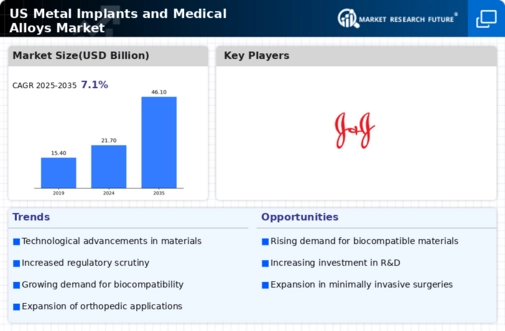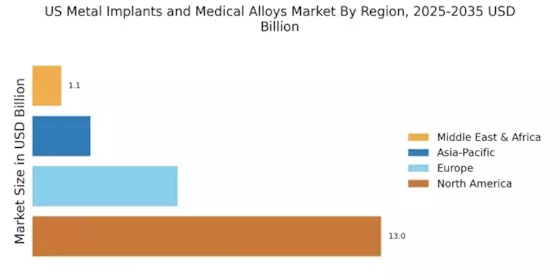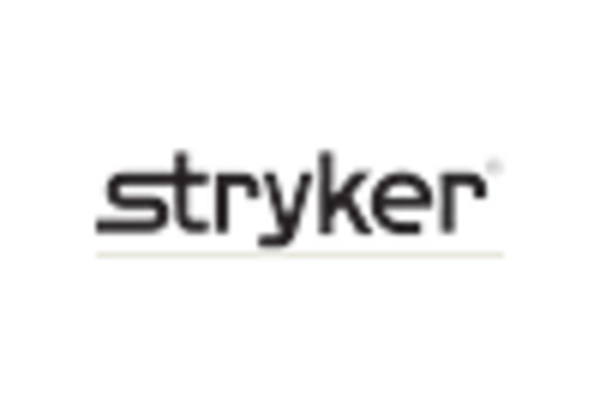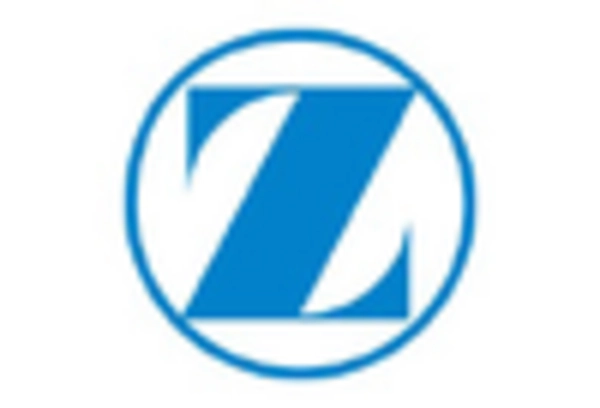Rising Demand for Orthopedic Procedures
The US Metal Implants and Medical Alloys Market is experiencing a notable surge in demand for orthopedic procedures, driven by an aging population and increasing prevalence of musculoskeletal disorders. According to recent data, the number of total joint replacement surgeries is projected to reach 1.2 million annually by 2025. This growing demand necessitates the use of advanced metal implants and medical alloys that offer enhanced durability and biocompatibility. As healthcare providers seek to improve patient outcomes, the focus on high-performance materials becomes paramount. Consequently, manufacturers are investing in research and development to create innovative solutions that meet the evolving needs of orthopedic surgeons and patients alike.
Regulatory Support for Advanced Materials
Regulatory bodies are playing a crucial role in shaping the US Metal Implants and Medical Alloys Market by providing support for the development and approval of advanced materials. Recent initiatives aimed at streamlining the approval process for innovative medical devices are encouraging manufacturers to invest in research and development. This regulatory environment fosters the introduction of new metal alloys that exhibit superior properties, such as enhanced strength and corrosion resistance. As a result, the market is likely to witness an influx of cutting-edge products that meet stringent safety and efficacy standards. The collaboration between regulatory agencies and industry stakeholders is essential for driving innovation and ensuring the availability of high-quality metal implants.
Technological Innovations in Implant Design
Technological advancements are significantly influencing the US Metal Implants and Medical Alloys Market, particularly in the design and manufacturing of implants. Innovations such as 3D printing and computer-aided design are enabling the production of customized implants tailored to individual patient anatomies. This shift towards personalized medicine is expected to enhance surgical outcomes and reduce recovery times. Furthermore, the integration of smart technologies into implants, such as sensors for monitoring healing, is gaining traction. As a result, the market is likely to witness an influx of novel products that not only improve functionality but also provide valuable data for healthcare providers, thereby driving growth in the sector.
Growing Awareness of Minimally Invasive Surgeries
The trend towards minimally invasive surgeries is reshaping the US Metal Implants and Medical Alloys Market. Patients and healthcare providers are increasingly favoring procedures that minimize trauma and promote quicker recovery. This shift is driving the development of specialized metal implants designed for use in minimally invasive techniques. As a result, manufacturers are focusing on creating lighter and more adaptable alloys that can be effectively utilized in these procedures. The market is likely to see a rise in demand for implants that facilitate less invasive surgical approaches, which not only enhance patient satisfaction but also reduce overall healthcare costs associated with longer recovery times.
Increasing Investment in Healthcare Infrastructure
The US Metal Implants and Medical Alloys Market is benefiting from increased investment in healthcare infrastructure, particularly in surgical facilities and rehabilitation centers. Government initiatives and private sector funding are contributing to the expansion of healthcare services, which in turn drives the demand for metal implants and medical alloys. For instance, the US healthcare expenditure is projected to reach over 4 trillion dollars by 2025, with a significant portion allocated to surgical procedures. This investment is likely to enhance the availability of advanced medical technologies, including high-quality implants, thereby fostering market growth. As healthcare facilities upgrade their equipment and capabilities, the demand for innovative metal solutions is expected to rise.

















